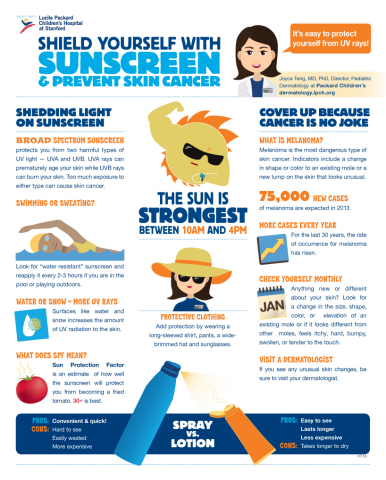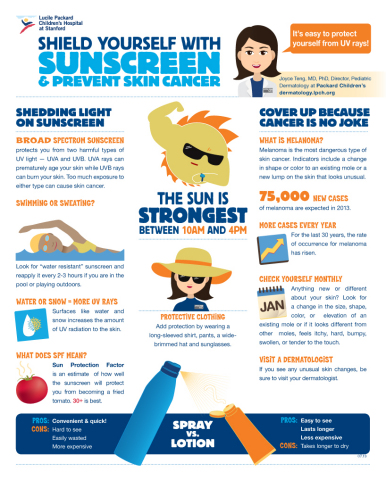PALO ALTO, Calif.--(BUSINESS WIRE)--There’s a massive and stifling heat wave hitting much of the United States this week, and that can mean skin damage from excessive sun exposure. For children, just one blistering sunburn can more than double their risk of developing melanoma later in life.
“Shielding yourself with sunscreen can prevent damage to the skin and reduce the risk of skin cancer later in life,” said Joyce Teng, MD, director of pediatric dermatology at Lucile Packard Children’s Hospital at Stanford and a clinical associate professor at the Stanford University School of Medicine. Teng noted that the rate of melanoma in America has been rising for the last 30 years. This risk has especially increased among adolescents over the last decade.
In the tips that follow and a new infographic attached and online, Teng offers advice on protecting your skin not only on excessively hot days, but also throughout the year.
Reporters can excerpt
* When outdoors, always use a broad-spectrum sunscreen that offers protection from two harmful types of ultraviolet light – UVA and UVB. Too much exposure to either type can cause skin cancer.
* Look for “water-resistant” sunscreen and reapply it every 2-3 hours if you are in the pool or playing outdoors.
* Even being in the snow requires sunscreen. That’s because reflected light from both snow and water increases the amount of UV radiation to the skin.
* Sun Protection Factor (SPF) is an estimate of how well a sunscreen will protect you from becoming a fried tomato. Sunscreen that is 30+ SPF may offer more than 97 percent protection when applied correctly.
* Check yourself monthly. A rapidly growing mole that is changing in color or shape could require a visit to the dermatologist.
These tips and others, including a comparison of SPF spray vs. lotion, are in Dr. Teng’s infographic attached and online. Discover more at dermatology.lpch.org.
About Packard Children’s Hospital
Lucile Packard Children’s Hospital at Stanford is an internationally recognized 311-bed hospital and leading regional medical network providing a full complement of services for the health of children and expectant mothers. Together, our world-class Stanford Medicine doctors, nurses and staff deliver innovative, nurturing care and extraordinary outcomes in every pediatric and obstetric specialty. Packard Children’s is annually ranked as one of the nation’s finest by U.S. News & World Report and the only Northern California children’s hospital with specialty programs ranked in the U.S. News Top 10. Learn more about our full range of preeminent programs at lpch.org and the Packard Children’s Health Alliance at PCHA.org. Like us on Facebook, watch us on YouTube and follow us on Twitter.





